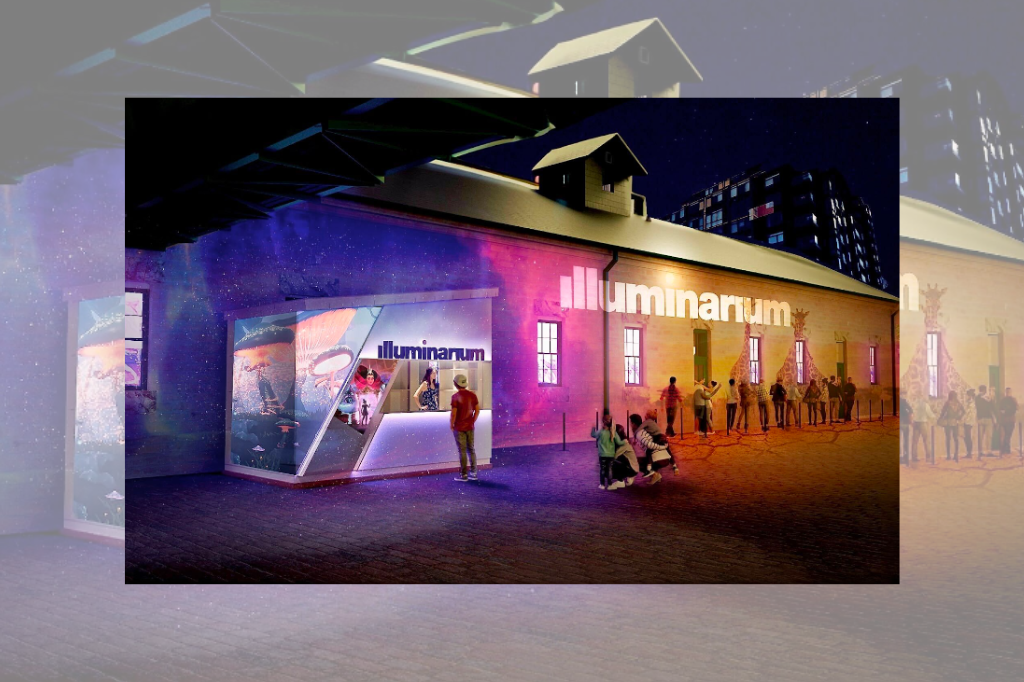REVIEW: Illuminarium at the Distillery District is yet another immersive experience for Toronto’s books
The Distillery District’s long-standing reputation as a vibrant hub of artistry has never been more contentious. With artists and arts organizations evicted from their studio space over the pandemic, this historic destination for culture and entertainment is slowly shifting towards a pay-to-play infrastructure.
Enter Illuminarium: the neighbourhood’s newest tenant which sits between craft and commodity.
The immersive entertainment company — building a name for itself with its 360-degree cinematic experiences and expansive projection mapping — has recently opened their first permanent location in Canada, and third in North America. With WAKING WONDERLAND and SPACE, Illuminarium at the Distillery District greets Toronto with two high-tech worlds to choose from.
But the media previews held before their official opening served more as a proof-of-concept than early admission. The almost utilitarian, fragmented experience delivered an environment that felt prepared for advertisement, but unprepared for an actual audience.
In this exhibition, Illuminarium joins forces with Secret Location, the Emmy award-winning augmented and virtual reality studio, to create a psychedelic steampunk adaptation of Alice in Wonderland. WAKING WONDERLAND follows Alice’s granddaughter as she embarks on a journey to find Wonderland and restore the magic that was lost when Alice left.
Through motion tracking and spatial audio soundscapes (composed by Juno Award-winning singer Lights), each fantastical setting involves moments for interactive gameplay and live character interaction, with costumes provided by the neighbouring Soulpepper Theatre Company. Visitors are free to wander the room as fluorescent visuals following Anna’s mission, with an embedded scavenger hunt that never crosses paths with the narrative. Adventure instead feels as if you were instead mimicking the animation of an unpaid arcade machine on its buttons. As a fusion of interactive media and immersive storytelling, WAKING WONDERLAND takes you to the rabbit hole and leaves you there.

Those looking for an out-of-this-world staycation can experience a simulated rocket launch and interstellar exploration with SPACE: A Journey to the Moon and Beyond. Upon blast-off, participants plunge into the depths and outskirts of our solar system. This installment beautifully reconstructs footage from the James Webb Space Telescope (JWST) to scale, giving audiences the opportunity to leave their own footprints on the moon. Without a doubt, SPACE arouses a breathtaking curiosity of the cosmos, but the events of space travel have been designed with limited imagination.
In both cases, the approach to immersion feels decorative, rather than fully developed — the immersive experience seems to prioritize aesthetics above all else. The production quality of WAKING WONDERLAND and SPACE may be jaw-dropping, but the novelty wears off quickly.
When the terms of engagement lack structure or specificity, it’s difficult to engage beyond the surface level. Because entrance to Illuminarium is permitted on a rolling basis, the exhibitions are without narrative or sequence. No matter what time slot someone enters, little is offered to situate the newcomer in the world they’re joining.
Other than the initial take-off, the lack of context SPACE provides renders itself more as an extravagant classroom slideshow than a simulated journey to the stars. The free-for-all nature feels like a missed opportunity for the performers, dressed as astronauts, to lead a guided tour of the galaxies or their space station. As a step further, the structure of the experience could be recruiting visitors for a specific mission, establishing goals and consequences for participation.
Even the character actors of WAKING WONDERLAND seem to have little involvement in the story being told, serving more as human props than agents of worldbuilding. Anna’s return to Wonderland could easily happen without the live presence of beloved figures, such as the Queen of Hearts or the White Rabbit. At times, it’s distracting with both in the room — it’s unclear who or what the audience should pay attention to. If character interaction had an objective, or the actors could drive the experience instead of complementing it, audiences at the event might have a purpose beyond witnessing the technological marvel.

Attention to detail seems to have been expended on creating the environment itself, but the experience as a whole needs more focus. Because the sense of immersion heavily relies on digital projections, the interactivity often exists as a brief and passive exchange with the technology. It’s hard to feel like you’re a part of an experience when your presence has no impact on the action itself. You can only jump on a digital asteroid for so long before realizing you could get a similar experience for less money at the Ontario Science Centre’s interactive koi pond.
There’s no purpose or impact fuelling your engagement, so there’s no incentive to participate. And once the wow factor dies down, what’s left?
From nightlife to gaming to interactive soundscapes, the scope of what this venue seeks to offer is promising. In conversations with Secret Location president and founder Ryan Andal during media previews, he noted interest in establishing Illuminarium as a popular destination for live events and immersive interpretations of classic films. On the other hand, an AV technician mentioned wanting to explore the prospect of an interactive musical experience, where genres might change as visitors move through the space.
What Illuminarium has brought to the city is an unprecedented technological artillery with unique possibilities for creativity and connection. With its state-of-the-art equipment, this versatile event space presents a critical opportunity to program large-scale interdisciplinary projects in collaboration with local independent artists for whom this infrastructure may be inaccessible.
Illuminarium at the Distillery District could easily become a hub of artistic cross-pollination and entertainment, as long as the company is willing to invest in the process and people to make it happen. Otherwise, they may suffer the same fate as its competitor Lighthouse Immersive, which recently filed for bankruptcy due to major drops in revenue. For now, tickets to Toronto’s newest augmented reality photo-op are available here.
Intermission reviews are independent and unrelated to Intermission’s partnered content. Learn more about Intermission’s partnership model here.












Comments